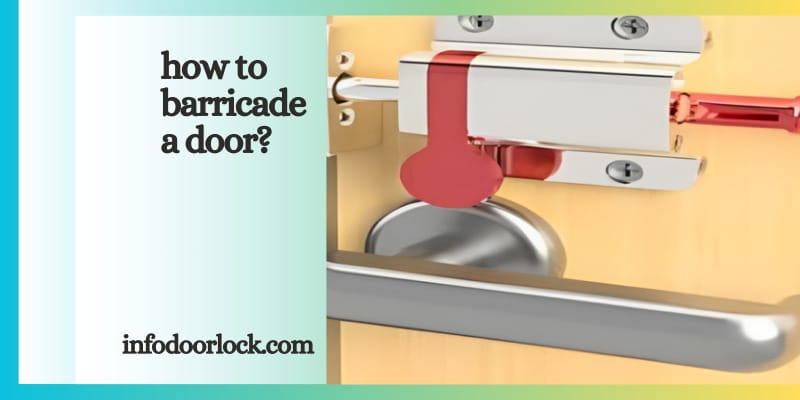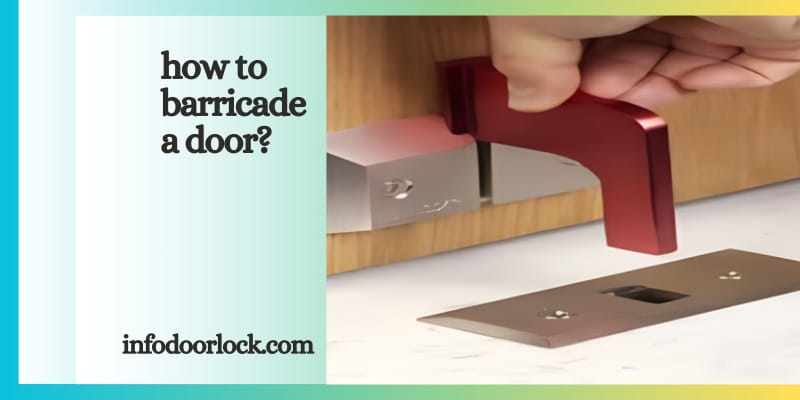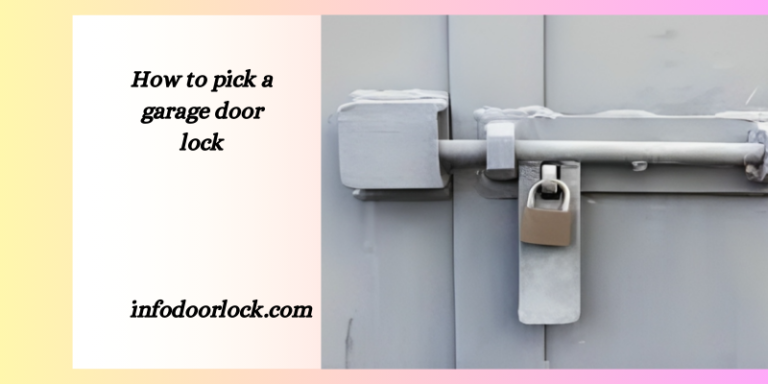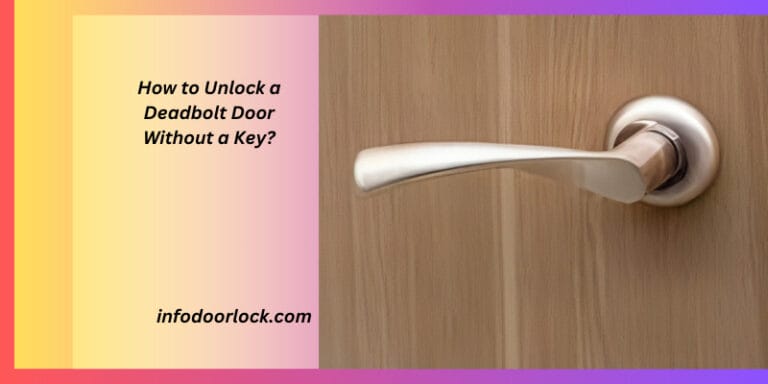“Barricade Like a Pro: Quick & Effective Door-Securing Tips”
In today’s unpredictable world, understanding a way to efficiently barricade a door may be a critical ability for ensuring private safety. Whether you are dealing with a natural catastrophe, a home invasion, or any other emergency state of affairs, the capacity to quickly and securely support your access factors can be lifesaving. This guide will delve into important door barricade techniques, providing practical and straightforward advice. Our goal is to empower you with understanding, address unusual worries, and provide insights into the significance of emergency preparedness. Stay knowledgeable and equipped to behave in the face of unforeseen dangers.
To barricade a door fast and effectively
Push heavy furniture against the Door:
- Use gadgets like desks, dressers, or bookshelves. The heavier, the higher.
Use door security devices:
- If available, use business door barricades or safety bars.

Wedge Items Underneath the Door Handle:
- This might be anything from a doorstop to a chair, particularly if the door opens inward.
Use belts or ropes:
- If the door has handles, tie them to nearby heavy furniture.
Block Visibility:
- Cover any windows inside the door to keep outsiders from seeing interior.
Stay quiet and Alert:
- After barricading, keep quiet and listen for updates or help.
Remember, these strategies are for emergency conditions, and it is important to constantly prioritize protection.
Materials Needed for Effective Door Barricading
To effectively barricade a door, you will want some primary materials, many of which may be observed in your property. Here’s a list in your reference:
Heavy Furniture:
- Couches, dressers, or any large, strong piece can be used to block the door.
Security Bars:
- Portable bars are designed to wedge against the door and ground for added electricity.
Door Wedges:
- Simple but effective, those may be placed underneath the door to keep it from establishing.
Rope or Heavy-Duty Cord:
- It is useful for securing doorknobs to heavy objects or furnishings.
Plywood or boards:
- In case you need to block a door with a broken lock or damaged body,.
Nails or screws (optionally available):
- For greater everlasting answers, especially in wood door frames.
Tools (hammer, screwdriver, etc.):
- Handy for putting in or reinforcing barricades.
Remember, the choice of substances may additionally vary primarily based at the sort of door you are securing and the nature of the emergency. Always prioritize safety and practicality when selecting your barricading equipment.

A Comprehensive Guide:How to Barricade a Door Effectively
1. Assess Your Door Type
Doors that open inward:
- These are easier to barricade since force from the outside will push the barricade in the direction of the door, increasing resistance.
Outward Opening Doors:
- It requires an unusual technique, as barricades want to face up to the pull pressure.
2. Clear the Area
- Remove any barriers close to the door that could avoid the barricading method or reduce stability.
3. Use Heavy Furniture (For Inward Opening Doors)
- Push robust furnishings (like a heavy desk or bookshelf) towards the door. The heavier, the higher.
- Ensure it’s positioned to brace in opposition to the door’s motion effectively.
4. Apply Door Wedges (For Both Door Types)
- Slide a door wedge firmly beneath the door. Use more than one wedge if it is to be had for additional energy.
5. Utilize Security Bars (For Outward Opening Doors)
- Place a protection bar under the door, ensuring it’s braced in opposition to the ground from a perspective to withstand pulling.
6. Secure with Rope or Cord (Alternative Method)
- Tie a rope or twine around the doorknob, then anchor it to a sturdy, immovable object in the room.
- This approach is particularly useful for doorways without handles or knobs.
7. Reinforce with Plywood or Boards (In Case of Damaged Doors)
- If the door or frame is damaged, use plywood or forums to cowl the door, nailing or screwing them in place.
8. Double-Check the Barricade
- Ensure that each factor is securely in the vicinity and that the door does not pass.

Safety Tips and Considerations
Choose the right materials:
- Use strong, heavy items like furnishings, desks, or filing shelves. Avoid the use of fragile gadgets that could, without problems, wreck under stress.
Stability is Key:
- Ensure the barricade is solid. Stack items in such a way that they help each other and might not effortlessly topple over.
Block Visibility:
- If feasible, use items that block the view through the door’s window, making it tougher for an intruder to see the interior.
Don’t Block Your Own Exit:
- Always have an opportunity to break out of direction in your thoughts. Don’t barricade a door if it’s your handiest way out.
Quick Removal:
- While the barricade has to be sturdy, make certain you can dismantle it quickly if necessary, such as while law enforcement arrives or in the case of a fireplace.
Reinforce the door:
- If time lets in, use belts or ropes to enhance the door to cope with the closest heavy object. This can add an additional layer of security.
Silence is Golden:
- After barricading, live quietly and maintain your phone on silent to keep away from drawing interest.
Common Mistakes and Concerns
Overestimating Strength:
- Don’t assume a small item will keep returning an intruder. Use more than one gadget to create layers.
Blocking key escape routes:
- Remember, safety exits are essential. Never barricade those paths.
Neglecting Door Type:
- Sliding doorways and doorways that open outward require one of a kind barricading techniques.

Conclusion: Essential Guide to Barricading a Door
Key Points Summary
Use sturdy materials:
- Opt for heavy, stable items like furniture to create a sturdy barricade.
Ensure Stability:
- Arrange items so that they help each other and can withstand being pushed over.
Block Visibility:
- Cover door windows to keep intruders from seeing inside.
Maintain an exit strategy:
- Always have a plan for an opportunity to break out.
Quick Dismantling:
- Set up the barricade in such a way that it can be unexpectedly taken down if important.
Additional Reinforcements:
- Use belts or ropes to stabilize the door, and take care of heavy gadgets for extra safety.
Stay Quiet:
- After barricading, limit noise and hold conversation devices silent.
Reiterating the Importance of Barricading for Safety:
Knowing a way to correctly barricade a door is a critical skill for personal protection in diverse emergency eventualities. Whether dealing with a home invasion or every other hazard, a well barricaded door can function as an important line of protection, buying treasured time and presenting safety. Understanding the proper strategies and substances for barricading, while also being aware of common errors, enhances your preparedness and capacity to respond efficiently in dangerous conditions.
FAQs on Barricading and Securing Doors
Q: How do you barricade a door without problems?
Answer: To easily barricade a door, use robust gadgets like fixtures (chairs, tables, or shelves). Push them in opposition to the door, making sure they’re stable and won’t easily topple. For doors that open inward, piling up these items without delay at the back of the door creates an effective barrier. This technique is quick, calls for no special equipment, and makes use of not unusual household gadgets.
Q: How do you rig a door so it cannot be opened?
Answer: Rigging a door to save you it from beginning may be executed by securing the door with a close-by heavy object. This may be completed using robust cords, belts, or ropes. Tie one end to the door handle and the opposite end to a heavy piece of furniture, making sure the line is taut. This technique works nicely for doorways that open inward.
Q: How do you block a door without problems?
Answer: A clean way to block a door is through the use of door wedges or doortops. Slide them under the door, specifically if it opens inward, to create friction and make it harder to open. You can also use heavy objects like bookcases or massive planters, setting them all at once towards the door. This is a brief and effective technique requiring minimal effort.
Q: How do you jam a door quickly?
Answer: To quick jam a door, you can use a transportable door lock or a protection bar. These tools are designed to be attached to the door or below the door handle, providing a right away barrier. If you do not have that equipment, jamming a chair underneath the door or placing heavy objects in opposition to the door are effective alternatives.








One Comment